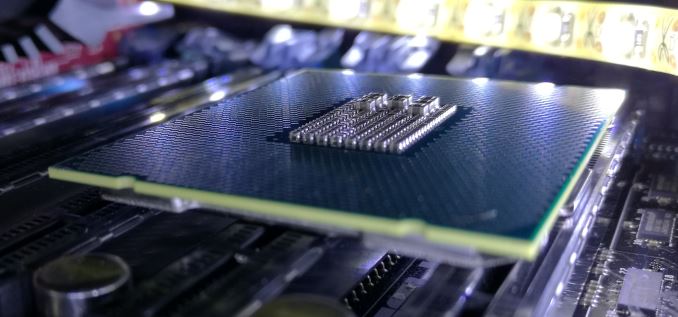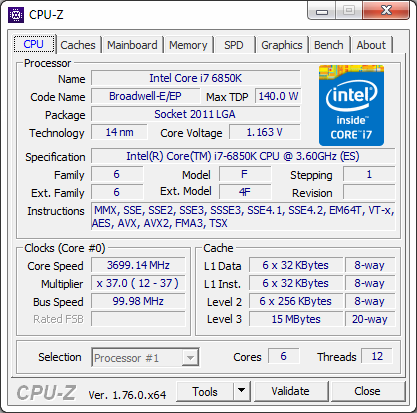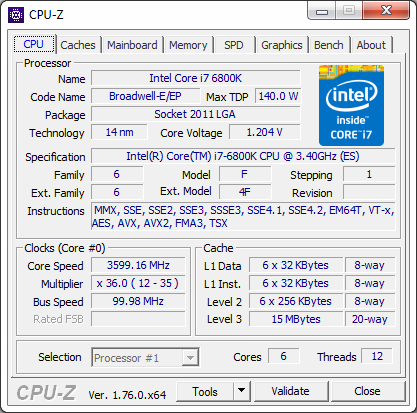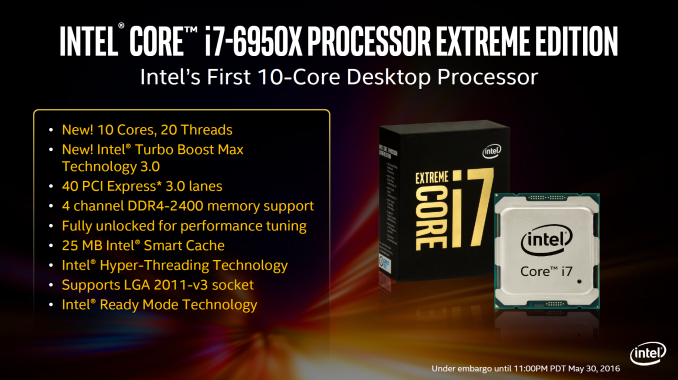The Intel Broadwell-E Review: Core i7-6950X, i7-6900K, i7-6850K and i7-6800K Tested
by Ian Cutress on May 31, 2016 2:01 AM EST- Posted in
- CPUs
- Intel
- Enterprise
- Prosumer
- X99
- 14nm
- Broadwell-E
- HEDT

What would you do with more CPU cores? This is a question I see posted from an Intel employee on a yearly basis, and it actually is a difficult question to answer depending on your computing background. A gamer might not need more than four or six, and a number of workstation use cases are now GPU accelerated. Anyone never in a pure compute situation might not need more than four or six cores.
But what about virtual machines, complex encoding, or non-linear functional compute? How many cores are too many? Intel has recently released the Broadwell-EP based Xeon E5-2600 v4 processors, running up to 22 cores, and the smaller silicon die used for the 10-core parts has today filtered down to the prosumer and high-end desktop (HEDT) markets in four different parts, making up the Core i7 6800 and 6900 series. For today's review we'll be taking a look at all four.
Broadwell-E: The Information
Intel’s HEDT platform cadence has been slowly falling further and further out of phase with their latest CPU microarchitectures. In 2015 we spoke extensively about the successor to Broadwell, Skylake, coming to the consumer and mobile platforms. Now it is 2016, and the HEDT discussion brings us back to Broadwell in the form of Broadwell-E. This out of step cadence occurs for several reasons, namely that the HEDT market is more an extension of the bottom of the enterprise/server market, rather than the extending the reach of the mainstream market. In the enterprise market, customers request stability and updates to appear at regular intervals with sufficient longevity of each platform.
The enterprise market, as Johan reviewed a few weeks ago, uses the name ‘Broadwell-EP’ and comes in three silicon floor plans depending on how many cores are in the final product. Broadwell-E, the HEDT set of processors, takes the smallest 10-core design and splits this into four SKUs to be used in consumer grade X99 motherboards. Most motherboard manufacturers will be releasing their second generation X99 motherboards for this launch, and some have done so already. We have an accompanying piece with this review going over the feature sets of as many new boards as we could find.
But here are the four new SKUs: the 10-core i7-6950X, the 8-core i7-6900K, the 6-core i7-6850K and the 6-core i7-6800K:
| Intel i7 HEDT Lineup | |||||||
| 6950X | 6900K | 6850K | 6800K | 5960X | 4960X | 3960X | |
| Cores | 10 | 8 | 6 | 6 | 8 | 6 | 6 |
| Threads | 20 | 16 | 12 | 12 | 16 | 12 | 12 |
| Base CPU Freq | 3.0 GHz | 3.2 GHz | 3.6 GHz | 3.4 GHz | 3.0 GHz | 3.6 GHz | 3.3 GHz |
| Turbo CPU Freq | 3.5 GHz | 3.7 GHz | 3.8 GHz | 3.6 GHz | 3.5 GHz | 4.0 GHz | 3.9 GHz |
| TDP | 140W | 130W | |||||
| Memory Freq. | DDR4-2400 | DDR4 2133 |
DDR3 1866 |
DDR3 1600 |
|||
| L3 Cache | 25MB | 20MB | 15MB | 15MB | 20MB | 15MB | 15MB |
| PCIe Lanes | 40 | 40 | 40 | 28 | 40 | 40 | 40 |
| Arch. | Broadwell-E | HSW-E | IVB-E | SNB-E | |||
| Price | $1723 | $1089 | $617 | $434 | $999 | $990 | $990 |
There’s a lot of information here to dissect, so let’s start with the one that will catch the most attention: the price.
(1) Price
In order to further separate the high-end desktop platform from their mainstream platforms, Intel has adjusted the pricing of the new Broadwell-E CPUs relative to the previous generations.
The top line 10-core CPU, the i7-6950X, comes in at $1723 at 1k tray pricing, with consumer pricing expected to be nearer $1749 or $1799 depending on stock levels and availability. This is a marked increase from previous top model Extreme Edition processors in the past, which Intel has offered at $999 ($1049 retail). The reasons for the change are somewhat unclear: one could argue that it’s a larger die and costs more to make, but this is the first 14nm HEDT part and should be smaller than an equivalent Haswell-E design. The main reason that springs to mind is simply market and price segmentation – Intel will state that enthusiasts have been asking for more in the overclockable high-end consumer space, so here it is (and here’s the price).
The 10-core is a full $634 more than the 8-core i7-6900K, meaning a 58% increase in price for only 25% increase in cores. We all know that once you reach the high-end, the price/performance curve goes off in a silly direction but if you want to keep the cream of the crop, there is an extra charge.
The i7-6950X also gets a unique retail box compared to the other processors, in a sleek black with gold lettering. This combination of colors tends to go down well with whoever loves gold, perhaps indicating that Intel is looking at a new kind of premium customer.
Moving on to the 8-core i7-6900K, and this part comes in above the previous top price: $1089 compared to $999. This makes it a rough upgrade from any 5960X users when the benefits are limited to the upgraded microarchitecture. As would be expected, while it has fewer cores in play than the i7-6950X, it still allows the base and turbo frequencies to be overclocked for users who run these processors above stock speeds. The processor is still unlocked, but it means a couple of things for users who have a Haswell-E system based on the i7-5960X already: spending another $1000 gets you no extra cores and the same chipset.
Ultimately one could argue that Intel is looking more to Nehalem/Westmere and Sandy Bridge-E users with Broadwell-E, as nearly every Intel presentation usually goes to quote current rates of 3-to-5 year-old systems that need upgrading. There are a few other features that users of Haswell-E systems might be interested in however, which we will cover.
The i7-6850K and i7-6800K are priced at $617 and $434 respectively, marking an increase in price in order to get onto the HEDT ladder from previous generations. These are six core processors, like the i7-5930K and i7-5820K from the previous generation, with similar limitations. The issue Intel has here is that the i7-5820K has been regularly running close or below its MSRP, making it an easy purchase for users that want a HEDT system (if only for the memory support). Making the base i7-6800K a $434 part rather than a ~$320 part means that a minimum outlay for a system (i.e. motherboard + CPU) is closer to $600 than $400, and less attractive to the top segment of mainstream users.
(1b) Xeon Price Competition
I would point out here that Intel is somewhat shooting itself in the foot with the pricing on the i7-6950X. The recently released Xeon Broadwell-EP processor list includes the Xeon E5-2640 v4: a 10-core 2.4 GHz/3.4 GHz part that runs at 90W, and is priced at $939, which compares favorably to the i7-6950X and its 10-cores at a 3.0 GHz/3.5 GHz clockspeeds. And because it’s a Xeon E5 processor processor, with the right motherboard a user can put two into the same machine for 20 cores/40 threads for only $1878, or only $150 more than the 10-core i7-6950X. There are other costs going into the dual processor market, but it opens up a wide margin.
Or how about finding a Xeon at a similar price? Try the Xeon E5-2680 v4 for $1745, which has 14-cores with hyperthreading for 28 threads, runs at 120W TDP and a 2.4 GHz to 3.3 GHz peak frequency. While the frequency is slightly down, that’s a 40% increase in cores for $22, gaining ECC support and a couple of extra hypervisor features in exchange for limiting DRAM to DDR4-2133 and losing overclocking.
The one downside to going the Xeon route is Xeons are only sold as OEM chips with a limited warranty. Intel only wants to sell these through vendors, so very few models ever make it into the retail market (and not always the ones you want).
(2) PCIe Lanes
When Intel introduced Haswell-E, it experimented with a new type of product separation: it also varied the number of CPU-host PCIe lanes among the SKUs. This practice continues in Broadwell-E, in an almost identical fashion. The lowest end CPU has 28 PCIe 3.0 lanes, capable of three-way GPU setups (and no 2x16 setups), while the other processors have a full 40 PCIe 3.0 lanes, allowing for four-way GPU setups or different combinations therein.
Typically the number of users investing in 3-way or 4-way graphics arrangements that implement SLI or Crossfire is very small, with many developers not bothering to optimize for multi-GPU beyond two graphics cards, so it could easily be a moot point for most users. That being said, fewer PCIe lanes means that some slots will have to operate at half bandwidth as a user expands, or users interested in many PCIe devices (GPUs with storage, RAID, and/or 10 gigabit Ethernet) might run out of lanes quicker. But therein lies the product segmentation – if a user need more PCIe lanes, then they need to spend a further $175 for the next processor up.
Back in our Haswell-E review, we did test the effect of having 28 PCIe lanes compared to 40 PCIe lanes on SLI and Crossfire graphics arrangements (or having PCIe 3.0 x16/x8 compared to PCIe 3.0 x16/x16). We found a sub-1% differential for dual-GPU gaming at the time. Due to timing we haven’t repeated the tests with Broadwell-E, and accept that it might matter more with DX12, but ideally we need more games on the market that support the different DX12 multi-GPU modes.
(3) Official Memory Support Increased to DDR4-2400
Within a single socket generation, we typically do not see a change in memory support for successive generations of Intel processors. The ‘official memory support’ of a processor defines the base JEDEC frequency and is the sole guaranteed frequency for the processor that meets the qualified error rates. The reality is that most processors will support faster memory, hence companies like Corsair, G.Skill, Kingston and others offer DDR4-3000 memory kits or faster, for those with bigger wallets. The reason why a CPU manufacturer does not qualify memory at that speed comes down to a number of factors, but as we mentioned, seeing a change within a socket is relatively rare.

One of the new Broadwell-E focused memory modules, a G.Skill TridentZ 16GB DDR4-3200 stick
In this case, the LGA2011-3 socket supports Haswell-E and Broadwell-E processors. The official memory speed supported for Haswell is DDR4-2133, and in our CPU/motherboard tests this is the speed we have been using. For Broadwell-E, this moves up to DDR4-2400, and we’ve sourced DDR4-2400 kits specifically for our testing. Ultimately the performance gain from increasing the memory speed by this small of an amount is minimal for most operations But for those specific use cases that require fast memory (WinRAR compression, RAMDisk/RAMCaches, in-memory virtual machines), they will sometimes see a benefit.
Who is Broadwell-E Aimed At?
Even just looking at the specification sheet, for anyone currently on a modern HEDT system it would be hard to see the value of investing in Broadwell-E unless peak performance is required at any cost. Intel's promotional pitch at launch, and through the length of the platform, will be aimed at users currently still on a Nehalem/Westmere (or even Sandy Bridge-E/Ivy Bridge-E) who want to move up from 4/6 cores and start using the features of the latest X99 platform:
Because of the pricing, it’s clear that the complete cost for a 10-core consumer machine, including memory, storage and graphics, will be a minimum of $2300 for a system with a basic GPU, or nearer $3000 for a high-end gaming platform. Meanwhile we may see Haswell-E in the channel for sale at the lower cost for at least a little while longer, in which case it may be seen as the more price attractive purchase at this time. Although aside from the main specifications, Intel will be hoping that some of the new features will also entice potential purchases.


















205 Comments
View All Comments
sor - Sunday, June 5, 2016 - link
Actually, without those benchmarks I wouldn't have known for sure that we were GPU limited or that CPU makes almost NO difference (I might have expected a few more FPS). I also found it interesting that one game stood out as being CPU limited.IUU - Sunday, June 5, 2016 - link
All good and awesome but Intel's persistence on maintaining many-core cpus as niche expensiveproducts is a dangerous strategy, that may ultimately lead to its downfall.
If the IT world would like to see a renewed growth, high performance computing should enter the lives of ordinary Joes. Plenty of apps could make their way into our lives via many-core cpus.
Games with really improved AI, local voice and image recognition, reading comprehension, advanced text editing, advanced 3d printing, etc etc.
Looking down on the needs of ordinary people, is nonsensical, for it is "simple joes", the needs of which led to many core cpus and advanced gpus,that the hpc world so much uses. No further development can come if the same old strategy is not applied.
Motion2082 - Monday, June 6, 2016 - link
What other XEONs would you recommend for 8 core?craveable - Tuesday, June 7, 2016 - link
Seriously, guys. My personal opinion is to skip Broadwell-E, unless you absolutely cannot wait till Q1 2017. It's a very realistic timeframe when Skylake-E will be released. Some journalist spotted a Gigabyte motherboard on Computex 2016, suited for Skylake-E, sporting a new LGA 3647 socket and 6-channel memory controller. Memory bandwidth was always a crucial selling point of HEDT CPUs, so a transition from 4 (current) to 6 (Skylake-E) is an important incremental update.craveable - Tuesday, June 7, 2016 - link
However, further studying of leaks reveled that the next HEDT will be released in Q2 2017 and be probably named Skylake-X. In the leaked roadmap the Skylake-X availability timeframe is strangely the same as for Kaby Lake-X.craveable - Wednesday, June 8, 2016 - link
However #2, it's likely, that only server part of Skylake (EP) will get LGA 3647 and 6-channel controller. And Skylake-X will get 4 channels and the same LGA 2011-3.galta - Wednesday, June 8, 2016 - link
There is no point in saying that someone should skip upgrading. But for budget constraints, if your processor is not good enough, you have to upgrade; if it still performs as you need, you do not need to upgrade, even if new generation has the same price and 50% more performance.It is said that Intel is trying to milk us with a +USD1,700 cpu and that not all softwares (games) are fully optimized for more than 2-4 cores, but if you still run a i7 9xx series, it is probably time to upgrade, even if Broadwell-E increase in performance is not huge.
mapesdhs - Thursday, June 9, 2016 - link
That makes no sense. You state that BW-E performance increase isn't that much, while saying someone with an X58 6c should still upgrade anyway. What for? Why would someone on a constrained budget spend so much for so little speed gain? Given the platform differences, X58 users would probably benefit more from newer storage tech such as M2 and newer USB3x, in which case a 5930K on a decent board would be more sensible (or a 5820K if they don't need the PCIe lanes). What you've suggested just sounds like upgrading for its own sake. These days there are far more nuanced options available, especially from the used market.fifa17 - Sunday, June 12, 2016 - link
I'm putting a system together and I'm stuck between Core i7-6850K and Core i7-6800K on a ROG STRIX X99 GAMING motherboard. The only confusing point is the number of PCI Express Lanes which is 28 for i7-6800K and 40 for the other. I've pre ordered the ASUS ROG Strix GeForce® GTX 1080 and don't plan on adding a second one in the future. I'm also not getting an optical drive of any sort and no HDDs. Just a 1TB Samsung 850 PRO SSD. Which CPU should I choose? Any ideas about these components?legolasyiu - Wednesday, June 29, 2016 - link
It will be best to get Core i7 6850 with 40 lanes for GTX 1080 16x with 850 Pro.